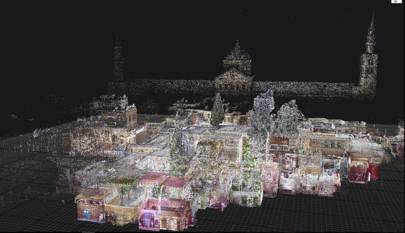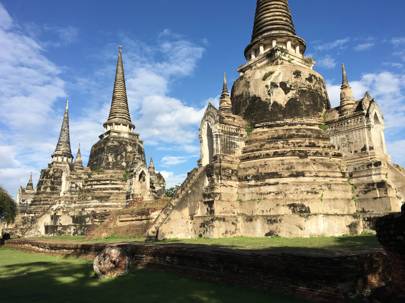In August 2015, Isis destroyed the 2000-year-old Temple of Bel in the Syrian city of Palmyra. Nearly three years later, and the city has been razed further. Alongside untold suffering and loss of life, Syria has seen the destruction of the Temple of Baalshamin, the Tower of Elahbel and Palmyra Castle – to name just a few.
It is the hatred of exactly this kind of destruction that led Ben Kacyra to found the not-for-profit organisation CyArk. In 2001, Kacyra – who is from Mosul in Iraq – watched on television as the Taliban laid waste to Buddhist statues in Bamiyan, Afghanistan, that had been built 1,500 years ago. Today sees the launch of Open Heritage, a partnership between Google Arts and Culture and CyArk (short for cyber archive) which aims to bring to a wider audience the most extensive and detailed 3D archive of imperiled archaeological wonders ever made.
It wasn’t simply coincidence that led Kacyra to opt for sophisticated 3D archiving as his tool of choice. Years earlier, he had helped to create the very first LiDAR scanner, which uses light lasers to build a detailed picture of a given scene with unprecedented speed. He saw that this technology could be used to preserve knowledge about sites and monuments facing a risk of destruction from human behaviour as well as natural disasters like earthquakes and floods.
Open Heritage will open up access to these sites in two ways. First, through an online archive which aims to give people all over the world visual access to a total of twenty-six sites, from Pompeii in Italy to Syria’s Al Azem palace. The data will also be open-sourced, meaning that researchers and archaeologists will be able to draw upon CyArk’s work in their own activities. “We wanted to make sure this was accessible to anyone, whether they’re on a phone, waiting for a bus, or at home on a high-end computer,” says Chance Coughenour, a digital archaeologist managing the project from Google’s end. Users can access the archive online or by downloading an app for iOS or Android, or immerse themselves more using fully virtual reality headsets such as the Daydream.
CyArk and Google are open-minded about where the archive could lead. “The mystery of what utility people might find in the data is part of the excitement,” says John Ristevski, Chairman and CEO of CyArk. “Some of the exciting frontiers are in virtual reality and augmented reality and we are excited to see what type of experiences people can build around heritage data – from immersive virtual tours to overlaying rich contextual information while you are on site – they all start with an accurate map of what is there.” There are hopes the data can also be put to use in further modelling and potentially even in reconstruction efforts in years to come.
CyArk has primarily used a combination of photogrammetry and LiDAR scanning to build up a picture of each site. Sending out light lasers – the same basic principle as radar and sonar – LiDAR rapidly builds up a detailed, textured picture of an environment known as a ‘point cloud’ by measuring the amount of time taken for the laser to return. Photogrammetry, on the other hand, uses photos to create a 3D picture of a space. Algorithms overlay different images of an environment, whether from handheld cameras or from drones, to create a replica of the structure.

Al Azem Palace
“LiDAR is still the cornerstone for data capture and was the only method for many of the early years of the organisation before digital photogrammetry became more ubiquitous,” Ristevski says. Today, despite the accuracy of cheaper digital photogrammetry, LiDAR “still is the most accurate method we have for capturing geometry and each point is accurate to about 5mm so we are able to build a very detailed surface model.”
It’s also a form well-suited to the intricacies of many heritage sites. “Ben’s invention was aimed at complex industrial environments such as oil refineries and submarines – things that were not so easily captured and described by traditional survey methods. The organic forms of many heritage sites are also hard to model so the application of LiDAR turned out to be a great fit and, combined with modern photogrammetry, can give us both accurate geometry and textures which are useful for a myriad of applications,” Ristevski says.

Ayutthaya
In August 2016, an earthquake struck the city of Bagan in Myanmar. CyArk had just undertaken a first field visit to the ancient city, which was the political, economic, and cultural centre of the Pagan Empire from 1044 to 1287, to assist Unesco and the Myanmar Department of Archaeology with conservation efforts. Built on a seismic fault, hundreds of temples were damaged in the earthquake, but CyArk was able to provide detailed evidence of the extent of the damage. Coughenour describes the site as a “best in class example of what you can do with this 3D data.”
In the app, viewers are guided through each site with an expedition overview that sets the scene for CyArk’s digital documentary, and an introduction to the site and its history. From here it breaks into 360° images of Bagan’s most impressive structures. Bagan is also the subject of a mini 3D documentary curated by the British Museum’s expert in Southeast Asian history, Alexandra Green, and narrated by the BBC’s Bettany Hughes. Moving into Ananda Ok Kyaung, a brick monastery built in the late 8th century, viewers are free to move around within the temple, and investigate the scenes of Buddhist cosmology which adorn the monastery’s walls.
Other sites are just a spectacular, but Coughenour’s personal favourite – and the one Ristevski said CyArk was most often asked about – is Mexico’s famous Chichén Itzá, one of the seven wonders of the ancient world. It’s a special site for him as an “avid fan of Mayan archaeology”. In particular, he’s excited by the opportunity to 3D model a structure at Chichén Itzá named the Caracol (meaning snail in Spanish, because of its shape).
This ancient astronomical observatory is rare for how well it’s stood the test of time, and because “there are not many circular structures in the Mayan world,” Coughenour says. “It’s been proven by researchers that the Maya used this to study the sun, sunsets, sunrise, the Equinox, and stars.”
Source: Wired





